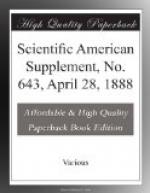The value of all this cannot be overestimated, for it will, even where prejudices as to our judgment may exist, gradually make it more and more clear that this society exists to promote and acknowledge improvements in every constituent of the microscope, come from whatever source they may; and, in connection with this, to promote by demonstrations, exhibitions, and monographs the finest applications of the finest instruments for their respective purposes.
To give all this its highest value, of course, the theoretical side of our instrument must occupy the attention of the most accomplished experts. We may not despair that our somewhat too practical past in this respect may right itself in our own country; but meantime the splendid work of German students and experts is placed by the wise editors of our journal within the reach of all.
I know of no higher hope for this important society than that it may continue in ever increasing strength to promote, criticise, and welcome from every quarter of the world whatever will improve the microscope in itself and in any of its applications, from the most simple to the most complex and important in which its employment is possible.
There are two points of some practical interest to which I desire for a few moments to call your attention. The former has reference to the group of organisms to which I have for so many years directed your attention, viz., the “monads,” which throughout I have called “putrefactive organisms.”
There can be no longer any doubt that the destructive process of putrefaction is essentially a process of fermentation.
The fermentative saprophyte is as absolutely essential to the setting up of destructive rotting or putrescence in a putrescible fluid as the torula is to the setting up of alcoholic fermentation in a saccharine fluid. Make the presence of torulae impossible, and you exclude with certainty fermentative action.
In precisely the same way, provide a proteinaceous solution, capable of the highest putrescence, but absolutely sterilized, and placed in an optically pure or absolutely calcined air; and while these conditions are maintained, no matter what length of time may be suffered to elapse, the putrescible fluid will remain absolutely without trace of decay.
But suffer the slightest infection of the protected and pure air to take place, or, from some putrescent source, inoculate your sterilized fluid with the minutest atom, and shortly turbidity, offensive scent, and destructive putrescence ensue.
As in the alcoholic, lactic, or butyric ferments, the process set up is shown to be dependent upon and concurrent with the vegetative processes of the demonstrated organisms characterizing these ferments; so it can be shown with equal clearness and certainty that the entire process of what is known as putrescence is equally and as absolutely dependent on the vital processes of a given and discoverable series of organisms.




